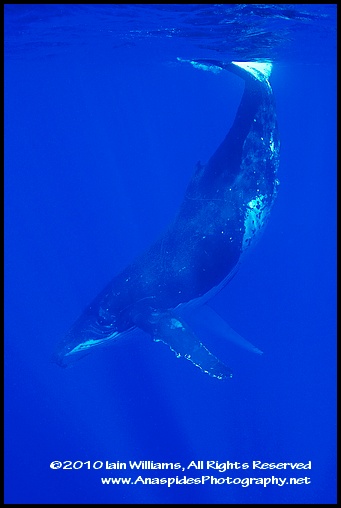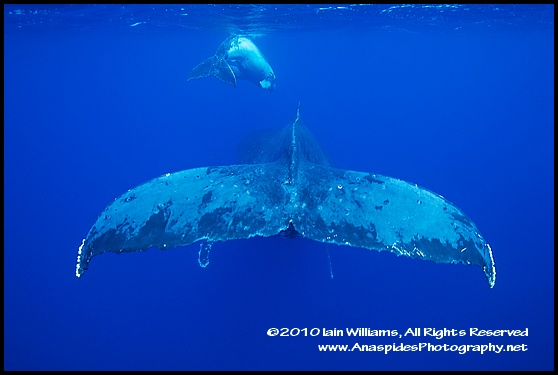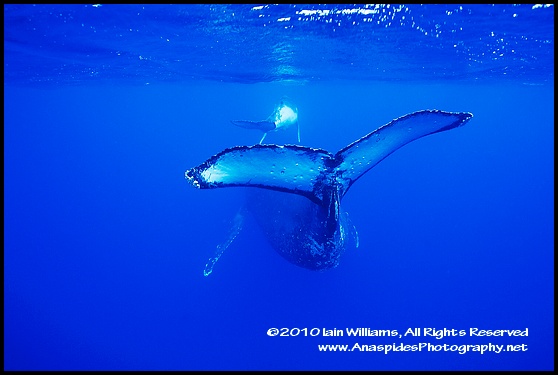 Pregnant Whale Upside Down - Birthing Position?
Pregnant Whale Upside Down - Birthing Position?
Cruising between two small islands, a whale was seen hanging upside down, it’s tail was above the water and its body was perpendicular to the surface. We cut the boat’s engines and drifted closer to the whale before deciding to slip over the side. Unfortunately, the underwater visibility on this day was not spectacular and the water appeared a dull blue rather than the normal indigo hue. Our whale guide thought the whale maybe sleeping, however, on closer observation it was discovered that the whale was a heavily pregnant female. Was the whale hanging upside down to sleep or to provide a better position to give birth? Brief research indicates that humpback whales, when about to birth, manoeuvre their bodies vertically in the water to aid in the birthing process, as this position allows the new born calf the greatest opportunity to reach the surface quickly to take its first breath of fresh air.
LEFT: Although not absolutely sure, there was a strong possibility that this whale was pregnant and about to give birth. Although not possible to see in this image, it appeared that the vaginal opening was slightly swollen indicating that birth would be relatively soon. Another whale (mid wife) was circling near by and often would approach the inverted whale to make head contact.
 Second Whale – Mid wife?
Second Whale – Mid wife?
We dived with the pregnant female for around 30 minutes before noting that another whale, perhaps a male escort or a whale charged with midwife duties, was swimming around the female. At first we had failed to see this whale as they can blend exceptionally well with the open water when at the extent of our vision.
LEFT: The second humpback whale approaches us closely. Was this whale the mid wife or just another male waiting to mate with the female after giving birth. It's behavioural moments like this which interest me the most.
Although the second whale was curious to our presence, it maintained its distance and proximity to the female. Eventually, both whales tired of our “company” and swam slowly away. Tempted to follow, we decided that to do so would verge on harassment towards the whale, we were happy to have spent the hour or so swimming with this whale, approaching close enough to touch her (although we didn’t touch), so we turned the boat in another direction in search of further photographic fodder.
 Huge Size – Minimal Danger
Huge Size – Minimal Danger
To swim with such a large mammal is a memorable experience, not so much because it’s a whale and is an intelligent animal, but more because of the size of the animal. Often when photographing the whales, I would stop looking through my wide angle viewfinder to note in amazement that the whale was only a meter (3 feet) or so from me.
LEFT: The massive flukes of female humpback whale dwarf those of a newborn youngster as they swim past me in Vavu'a in the Kingdom of Tonga. You can almost hear the baby whale saying to mother "look mum I can swim like you"
At no time during any of the encounters did I  feel in danger, although I will admit that on a few occasions I did feel some trepidation, especially when I had accidentally positioned myself over a tail. I remember vividly the pressure wave from the tail of a whale as it propelled itself forward. To be struck by a tail or pectoral fin, would no doubt cause injury.
feel in danger, although I will admit that on a few occasions I did feel some trepidation, especially when I had accidentally positioned myself over a tail. I remember vividly the pressure wave from the tail of a whale as it propelled itself forward. To be struck by a tail or pectoral fin, would no doubt cause injury.
LEFT: Note the round pattern on the underside of the flukes. These are bites from cookie cutter sharks. These deep water sharks bite into the flesh then spiral their bodies to remove a donut-shaped piece of whale.
Humpback Whale calves to come.....